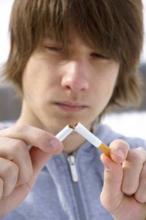Investigators have identified 10 significant indicators for smoking cessation by adolescent students and say that those antismoking efforts should address an array of factors, including dependence, among other factors that affect youth.
"Youth tobacco-control programs that do not consider nicotine dependence symptoms in novice smokers may not be optimally effective," Jennifer O’Loughlin, Ph.D., professor in the department of social and preventive medicine at the University of Montreal, and her colleagues said in a report in Cancer Epidemiology, Biomarkers & Prevention. Their study attempted to gauge smoking habits of young novice smokers, those who have smoked for only a year or 2.
Data on teenage smoking habits came from participants enrolled in Nicotine Dependence in Teens, a study that collected data from 1,293 students every 3 months over the course of 5 years. Students were aged 12-13 years at baseline.
As expected, nicotine dependence had a negative effect on smoking. Although the data were presented with a number of covariables accompanying nicotine dependence – including tolerance – the authors found that "nicotine dependence symptoms, such as cravings, emerge as early as 5 months after initiation in some novice smokers, and that tolerance appears at 14 months," the researchers wrote.
Overall, they said, "Male sex, age, susceptibility to cigarette package warnings, participation in team sports, family stress, worrying about weight, overweight, use of illicit drugs, tolerance, and other nicotine dependence symptoms seem to be associated with smoking discontinuation in novice adolescent smokers" (Cancer Epidemiol. Biomarkers Prev. 2014;23[6]June [doi:10.1158/1055-9965.epi-13-0869]).
Conversely, the study found students whose parents smoked, who had stressful family lives, polysubstance abuse, body-weight issues, or adolescents who started smoking earlier in life were less likely to quit than were their peers. The investigators studied 37 potential predictors.
"Tobacco-control programs and policy targeting novice smokers may be more effective if these factors are taken into account in their conceptualization, design, and implementation," Ms. O’Laughlin and her associates wrote.
Data from 620 participants were included in the study. Regular follow-up found that approximately 40% discontinued smoking, defined as not smoking for more than a year. Most who quit were light smokers. Of those who stopped, more than 70% smoked 0-2 cigarettes/per month.
Among the findings:
• Boys were 80% more likely to discontinue smoking than were girls.
• Older adolescents were 30% more likely to discontinue than were younger adolescents.
• Participants who said cigarette package warnings made them afraid to smoke were 44% more likely to quit.
• Adolescents who participated in team sports were more likely to quit than were their nonsmoking peers (44% and 40%, respectively).
Students were recruited from 10 secondary schools in Quebec. Data used in the analysis was self-reported; the researchers said that more in-depth research on each predictor would eventually be needed.
The study was funded by the Canadian Cancer Society. The authors did not disclose any potential conflicts of interest.


